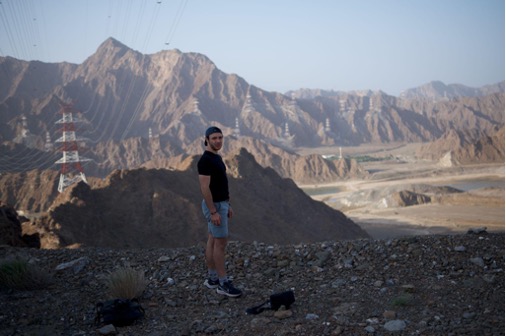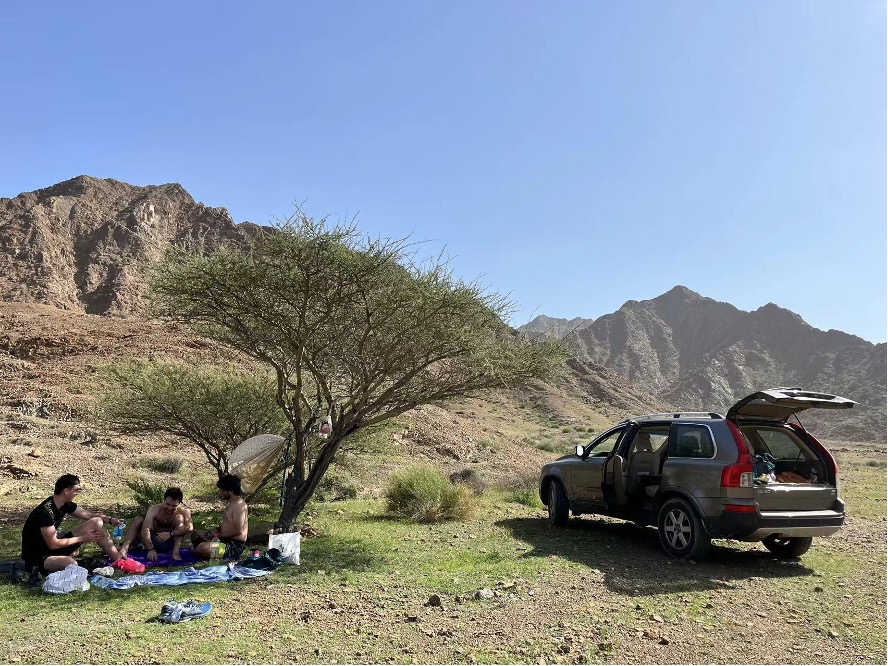While the concept of net-zero emission pathways has taken the world by storm, its practical implications are not very clear. What does it mean for people living their everyday lives? Is net-zero a utopian future with technology, or perhaps a future where humans take back their love for nature? What does the future look like and what are young people thinking about when it comes to net-zero?
The eARThumanities reimagining net-zero initiative traveled with three NYU Abu Dhabi students on an adventure-filled two-day camping trip, with a half-marathon trail hunt on the second day, to the Emirate of Fujairah in the United Arab Emirates, located on the Gulf of Oman. Daniel, Hannah and Sebastian come from South Africa, the United States, and the Czech Republic and over two days of casual conversations provide their questions, perspectives and vision for a net-zero world.
The depth of the conversation and the need to ponder upon how a net-zero future looks like on a day-to-day basis for people passionate about something like adventure sports motivated this article. The conversation around net-zero emissions is a humbling one. While all three students have heard the term in recent years, their first response was a question about what net-zero emissions actually means, and how it fits into the larger scheme of the environmental movement including climate action, biodiversity and wildlife conservation.

Hannah, a climate activist and senior at NYU Abu Dhabi, is particularly passionate about climate action. In addition to being a climate warrior, she is an adventure athlete, constantly pushing her mind and body further in search of adventure. As a skiing enthusiast, she provides an interesting perspective and asks probing questions about what a net-zero world would look like for the skiing industry. Apart from the negative impacts of ski resorts on the ecology by cutting down trees, destroying natural habitat for wildlife and use of artificial snow, they also have a large carbon footprint with their energy usage to power ski lifts, snowmaking and lodge operations. Not to mention, tourists fly and drive across the world to ski resorts leading to increased emissions.
Many of the operational issues seem solvable in a net-zero world. Renewable energywhich can power ski resorts is booming, and there is rapid innovation in transportation systems for low-carbon mobility. However, the notion of winter sports in a rapidly warming world presents interesting dilemmas.
The conversation leads to more questions than answers, as it should. What does it mean for the skiing industry to go net-zero in a warming world? Should they start thinking about it? While the conversation did not lead to any solutions, it brought about interesting questions on imagining what a net-zero future would look like, says Hannah.
Sebastian, a physics major from the Czech Republic who has an extensive background in endurance sports, feels strongly about the technological innovation happening in the adventure sports industry. This ranges from a growth in the use of battery technology in mountain biking, to high-end gadgets that aid adventure seekers. As we struggled driving our fossil-fuel based family SUV to the mountains, we fondly talked about the innovation in electric vehicles and how they have transformed into these robust adventure machines capable of off-road touring. Electric vehicles and low-carbon mobility are the future of transportation, Sebastian says.

But while he commends the role of technology and innovation, he is also curious about how this evolves as we try to tackle climate change and move towards a net-zero world. He emphasizes the need to build efficiency but also acknowledges that we need to keep checks and balances on the culture of consumerism. In other words, it should not just be about carbon accounting but also decreasing our overall consumption of technology as that directly affects energy usage. Conversations with Sebastian ranged from his personal experiences, having previously worked extensively on Sustainable Development Goals (SDGs) to his queries on the raw materials needed to accelerate the world towards a net-zero future.

Daniel, a computer science student at NYUAD, comes from South Africa. As much as he looks back on his connection with nature growing up, he also notes how portraying “access to nature” as a touristy thing has made nature inaccessible to his fellow South Africans. National parks have hefty fees and are targeted towards rich tourists, leaving locals excluded from the environment that is home for them. Daniel speaks of the need for the future of the environmental movement, be that climate action, biodiversity conservation, or a net-zero future, to be just and inclusive.
He questioned what net-zero meant for local farmers or tour guides and wondered if we can make nature accessible to everyone while envisioning a net-zero future. We also talked about how adventure sports, or even sports in general, can be one way of connecting people with nature and how we need to move towards that in the future. After all, his love for nature and dedication to climate action comes from his upbringing and interactions with nature.

The conversations over the two days were insightful and enlightening. But above all, they weren’t about new innovations and a pursuit for technocratic solutions. They were grounded in personal experience and reality. Perhaps being surrounded by the mountains in Fujairah, eating fruits, granola bars, and vegan peanut butter sandwiches and running a half marathon helped to reflect on each other’s lives and question what a future without climate change would look like for young people. And importantly, what a future for adventure seekers and athletes would look like.
We left the trip with more questions than answers, but with more imagination and understanding. One thing is clear: adventure sports, like every other industry, will have to move towards a net-zero future. It is time people in the industry start thinking about it as much as individual athletes and adventure seekers start contemplating it.
Industry associations of adventure companies for climate action and a net-zero world will be a good start. They can help each other innovate, share best practices, and enable each other to transition together. Industry standards, for example, are a good way to establish credibility and confidence on climate action. Finally, a shift to net-zero world for the adventure sports industry needs to consider stories and lived experiences of adventure seekers while incentivizing a broader audience to be grounded in nature.
*All photos are taken by Hannah Greene, Sebastian Kalos and Daniel De Beer

